This orange coloured Chanterelle is one of the smallest in the UK and can be found growing singly or in scattered groups.
Home / Mushroom Guide /
Orange Chanterelle
Orange Chanterelle
| Mushroom Type | |
| Common Names | Orange Chanterelle, Siantrel Melyngoch (CY), Pieprznik Pomarańczow (PL), Narancsvörös Rókagomba (HU) |
| Scientific Name | Cantharellus friesii |
| Synonyms | Merulius friesii, Craterellus friesii |
| Season Start | May |
| Season End | Sep |
| Average Mushroom height (CM) | 1-4 |
| Average Cap width (CM) | 1-4 |
Cap
1-4 cm. First rounded to convex, later flattened, finally more funnel shaped. Orange/yellow fading to more orangish with age. Margin is incurved when young, later become irregular and wavy.
Gills
Only has pseudo-gills or ridges, not real gills. They run down the stem (decurrent), narrow, vein-like, often forked. Orange to paler yellow/orange.
Stem
1-3.5 cm. Cylindrical and tapered towards the base. Orange to pale yellow/white, can bruise slightly rust brown.
Possible Confusion
The False Chanterelle (Hygrophoropsis aurantiaca), pictured, looks similar but when cut in half it does not have the white flesh of the true Chanterelle but is concolorous with the cap, and its gills are more crowded. Said to be edible but poor in older books, it can apparently cause food poisoning symptoms and even hallucinations for some people so it’s better avoided.
The poisonous Jack O’Lantern (Omphalotus illudens), is a very rare mushroom in Britain, it grows on deciduous wood, it has true gills and is bigger and darker orange in colour.
Chanterelle (Cantharellus cibarius), is a much more yellow colour. It is normally larger and prefers more acidic soil. It has broader mycorrhizal partner range, prefers Beech, Birch, Oak, Spruce and Pine. Its fruity smell is similar to apricot.
Amethyst Chanterelle (Cantharellus amethysteus), has various yellow based colour with a hint of purple to amethyst at the centre. It also prefers acidic soil, fruiting under hardwoods, e.g. Oak, Beech and Birch, but occasionally under conifers, e.g. spruce.
Frosted Chanterelle (Cantherellus pallens), is similar but larger and has a pale yellow cap with a dusting of white, particularly near the middle.
Pale Chanterelle (Cantharellus ferruginascens), looks rather similar to the Frosted Chanterelle, however there is no whitish dust-like cover at centre of its cap. It is one of the rarest amongst the Chanterelles in the UK.
Taste / Smell
Excellent. Smell, fruity.
Frequency
Not common.
Spores
Ellipsoid. Pale yellow to orange.
Other Facts
In March 2025 the IUCN (International Union for Conservation of Nature) added 1000 fungal species to the IUCN Red List of Threatened Species. The IUCN (Global) Conservation Status of St. George’s Mushroom (Calocybe gambosa) is: LC – Least Concern, without knowing with certainty if the population is stable or decreasing at the moment. For more information, see on the following link.


















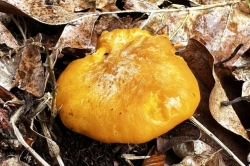
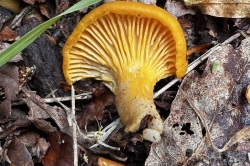

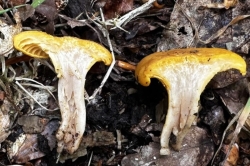

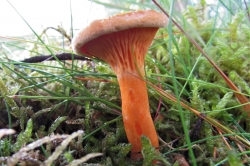
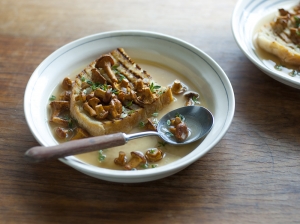






Leave a Reply